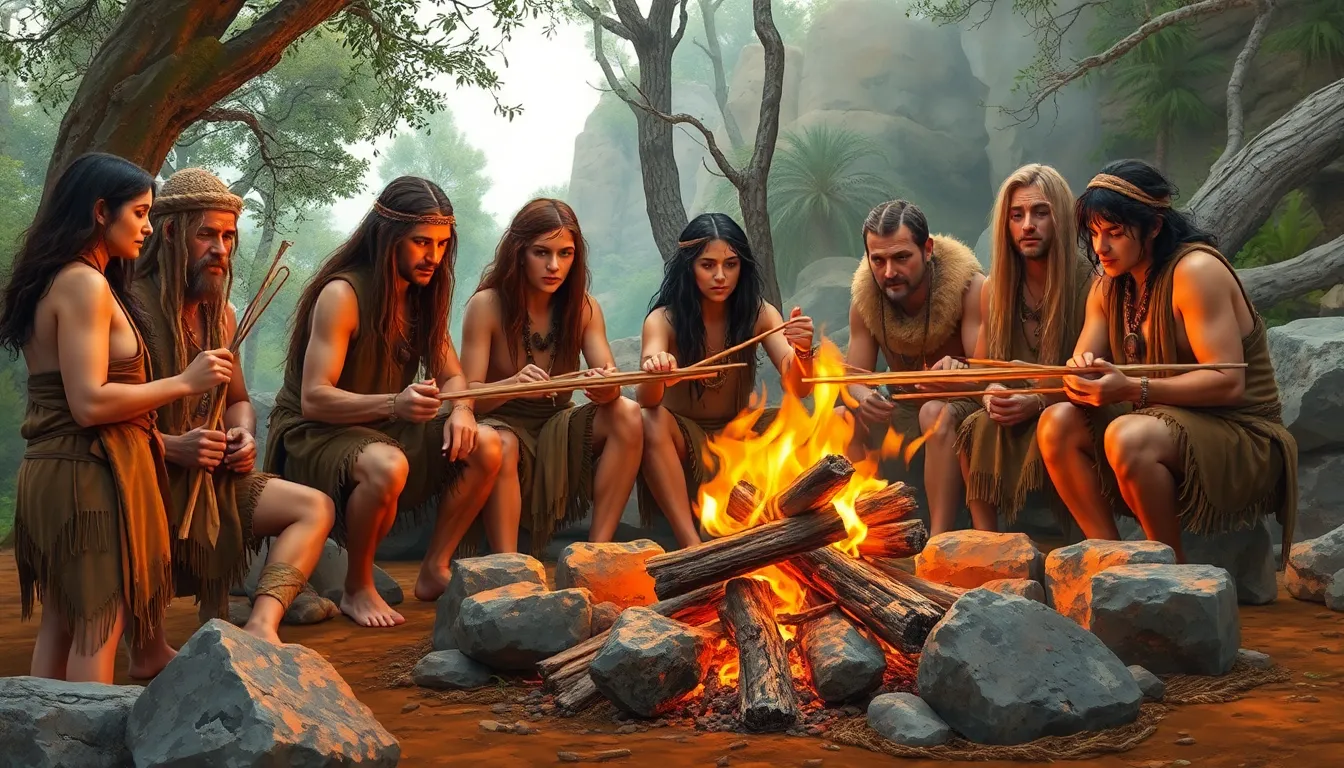Imagine a world where everything is raw, from vegetables to meat, and dinner is just a game of who can chew the toughest steak. Thankfully, someone had the brilliant idea to cook food, transforming our meals and our lives forever. But who was this culinary genius?
Who Invented Cooking
Cooking has roots tracing back millions of years. Early humans likely began heating food over fires to improve taste and safety. Evidence suggests that hominins started using fire for cooking approximately 1.5 million years ago, as indicated by archaeological findings.
The transition from raw to cooked food played a crucial role in human evolution. Cooked meals contributed to greater energy availability, leading to developments in brain size and functionality. Nutrient absorption also increased with cooking, allowing early humans to thrive.
Throughout history, different cultures developed unique cooking techniques. Ancient Egyptians utilized oven baking and roasting methods. Greeks introduced techniques like steaming and boiling, while Romans popularized sauces and sophisticated culinary practices.
With the advent of agriculture around 10,000 BCE, cooking further evolved. Cultivating crops enabled civilizations to experiment with various ingredients. They began to document recipes and share culinary knowledge, fostering the growth of diverse food traditions.
Culinary advancements continued during the Middle Ages. The introduction of spices from Asia and the influence of the Islamic Golden Age enriched European cuisines. In the Renaissance period, chefs began to focus on presentation and complex flavors, emphasizing art in cooking.
By the 19th century, the Industrial Revolution changed cooking once again. Innovations in technology, like gas and electric stoves, made cooking more accessible. Home kitchens transformed into spaces equipped with modern appliances, allowing for convenient meal preparation.
The invention of cooking marked a significant milestone in human history. Various cultures contributed to its evolution, shaping the diverse culinary landscape seen today. This transformative practice continues to impact nutrition and societal development.
Early Cooking Techniques

Cooking evolved significantly with early techniques that transformed food preparation. These methods laid the foundation for culinary practices that followed.
Use of Fire
Fire played a crucial role in the development of cooking. Around 1.5 million years ago, hominins began using fire to heat food. This innovation improved taste and safety, while also making food easier to digest. The ability to cook with fire allowed humans to access more nutrients. Archaeological evidence shows sites where ancient tribes utilized fire for cooking, indicating its widespread adoption in early cultures. Through this mastery of fire, early humans not only enhanced their diets but also fostered social interactions around shared meals.
Primitive Cooking Methods
Primitive cooking methods varied greatly among early populations. Roasting over open flames served as one of the most common techniques. Early humans often used stones to hold heat and cook food slowly. Other methods included steaming food in leaves or underwater, which preserved flavors and nutrients. Throughout various regions, communities adapted their cooking strategies based on available resources. Such practices reflected a deep connection to the environment and a commitment to nourishing their tribes. As agricultural practices developed, primitive methods evolved further, paving the way for more sophisticated culinary techniques.
Evolution of Cooking Through Ages
Cooking has transformed significantly through the ages, influencing cultures worldwide. By understanding these changes, one can appreciate the rich history of culinary practices.
Ancient Civilizations
Early civilizations showcased diverse cooking methods. Egyptians baked bread in clay ovens, showcasing advancements in food preparation. Mesopotamians utilized cooking pots for stews and soups, marking the beginning of complex culinary traditions. In Asia, the Chinese developed stir-frying techniques that utilized high heat for swift cooking, preserving nutrients. Native American groups cooked with the earth oven method, demonstrating a deep connection to local ingredients. These innovations reflected both agricultural developments and cultural exchanges among civilizations.
The Middle Ages
The Middle Ages brought significant culinary transformations across Europe. Spices became valuable commodities, influencing trade and enhancing flavors in dishes. Cooks in medieval kitchens experimented with various techniques, such as roasting meats and creating preserved foods. Islamic culture impacted European gastronomy, introducing new ingredients and cooking methods. With the growth of feudalism, communal dining became popular, fostering social bonds through shared meals. As nobility began to separate culinary practices from commoners, distinct cooking styles emerged, laying the groundwork for modern European cuisine.
Cultural Perspectives on Cooking
Cooking reflects diverse cultural identities and practices worldwide. Each civilization has contributed unique techniques and flavors, making cooking a universal language of sorts.
Global Contributions
Asian cuisines emphasize techniques like stir-frying and steaming, showcasing local ingredients and flavors. European traditions highlight baking and roasting, with each region developing distinct styles. African cooking often includes stews and grilling, utilizing indigenous spices and cooking methods. Indigenous peoples of the Americas used earth ovens and natural resources to craft meals, imparting a connection to the land. These approaches illustrate how geography and environment shape culinary practices.
Influential Figures
Chefs throughout history have shaped cooking as an art form. Auguste Escoffier revolutionized French cuisine, introducing techniques that laid the foundation for modern culinary schooling. Julia Child popularized French cooking in America, bridging cultural gaps and inspiring home cooks. Alice Waters emphasized sustainable sourcing and seasonal ingredients, influencing contemporary farm-to-table movements. Renowned chefs like Masaharu Morimoto demonstrate the fusion of traditional and modern techniques, enriching global culinary landscapes. Each of these figures has contributed to cooking’s evolution, signaling its role in cultural exchange and innovation.
Modern Cooking Techniques
Modern cooking techniques reflect the evolution of culinary practices, integrating advanced tools and methods. Sous-vide, for instance, involves vacuum-sealing food and cooking it at precise temperatures in water baths. This technique preserves flavor and moisture, enhancing dish quality.
Braising combines cooking methods, incorporating both moist and dry heat. This technique allows for tenderizing tougher cuts of meat, resulting in rich flavors. Techniques like sous-vide and braising exemplify the shift towards precision and control in modern cooking.
Searing is essential for developing flavor and texture. Chefs heat pans until hot and then cook meats quickly, creating a caramelized crust. This quick process intensifies the overall taste while maintaining juiciness.
Fermentation also plays a crucial role in the culinary landscape. This ancient method cultivates beneficial bacteria, enhancing flavors and health benefits. Foods like kimchi and yogurt showcase the versatility of fermentation across various cuisines.
Smoking infuses dishes with distinctive flavors through the exposure of food to smoke. Techniques vary by region, with cold smoking imparting subtle flavors and hot smoking fully cooking the food. This method has become popular in contemporary kitchens, adding depth to familiar ingredients.
The rise of molecular gastronomy highlights science’s influence on cooking. Chefs use chemical processes to transform textures and flavors, resulting in innovative dishes. A signature dish might include edible spheres or foams, surprising diners with unexpected experiences.
These modern techniques not only elevate culinary experiences but also encourage a deeper connection to food. Cultural influences continue shaping cooking methods, ensuring that each technique serves as a bridge between tradition and innovation.
Conclusion
Cooking stands as one of humanity’s most significant achievements. It transformed diets and shaped societies by enhancing flavor and safety. As cooking evolved through various cultures and eras, it not only improved nutrition but also fostered social bonds and cultural identities.
The journey from primitive fire use to modern culinary techniques illustrates the creativity and adaptability of humans. Each civilization’s unique contributions have enriched global cuisine, making cooking a reflection of cultural heritage. Today, as culinary practices continue to innovate and evolve, the art of cooking remains a vital part of human experience, bridging gaps and celebrating diversity.

